 |
| Tomatillo in the wild...of my garden |
 |
| Just starting to split the husk |
 |
This year, I wisely decided to get three plants, just to test the theory and make sure we were completely overrun with tomatillo. All three plants have thrived this year. We are really only at the beginning of the great 2011 tomatillo harvest, but I have already canned one batch of salsa and made a couple fresh batches. I have also picked a bag full and completely forgotten about them in the crisper drawer of the fridge. Funny how that happens...
Last week my mom was here for a canning/freezing extravaganza and the last day of her visit we made Salsa Verde, or Tomatillo Salsa. When I make White Chili I usually throw some salsa verde in there towards the end of its cooking time. I have also gotten really
Tomatillo Salsa
5 ½ C chopped husked tomatillos (2 lbs)
1 C chopped onion
1 C chopped green chili peppers (I used a mix of Anaheim and jalapeno)
4 cloves garlic, minced
2 Tb minced cilantro
2 tsp cumin
½ tsp salt
½ tsp red pepper (I used chipotle chili powder)
½ C vinegar (I used apple cider vinegar)
¼ C lime juice
Combine all ingredients in a large saucepot. Bring to a boil, then reduce heat and simmer 10 minutes. Ladle hot salsa into hot jars, adjust lids and rings, process 15 minutes in boiling water canner. Yields about 2 pints.
I canned this in half-pint jars and got 5 full jars .
Here is a crazy side-note...once when I was making my pork roast and threw in this salsa, the garlic in it turned a fascinating shade of greenish-blue. Needless to say, I was a little freaked out, but after a little internet searching, I found that it is a perfectly normal reaction that sometimes occurs when garlic comes in contact with other acidic foods.
 |
| Wash them really well to get that funky sap off! |
When I am just making salsa to eat fresh, I quarter the cleaned tomatilloes and throw them in a pan with some onion, garlic, jalapeno, cumin, and salt. Cook just until they break down a little, add cilantro, then whir it in the blender a bit until it gets to the consistency I want. If I have a little more time and don't mind heating up the kitchen a bit, I will roast the tomatilloes, onions, and peppers in the oven for a little while then process them in the blender with the other ingredients.
I haven't tried it yet, but I have read that to can plain tomatilloes you process them like tomatoes. I am also planning on freezing some the next time I pick a bunch, so I'll let you know how that turns out.



No comments:
Post a Comment